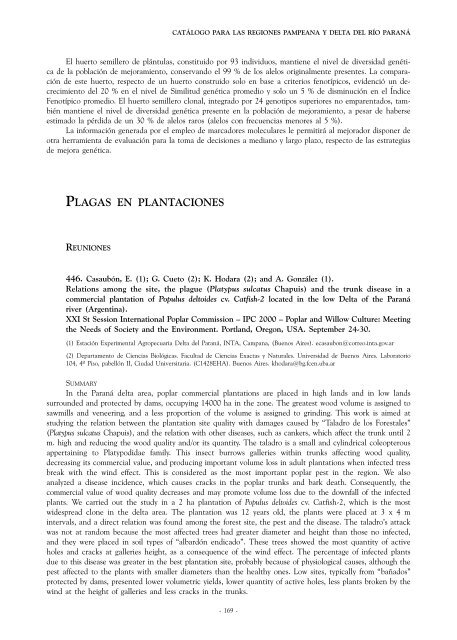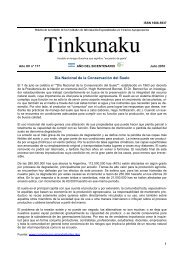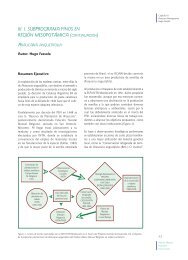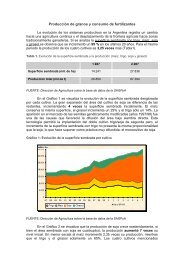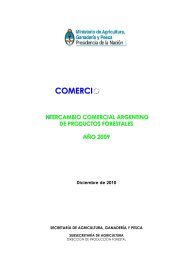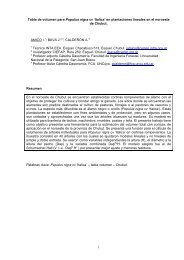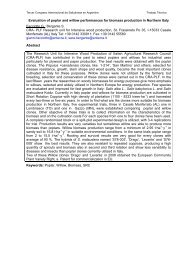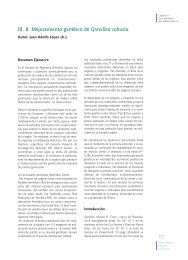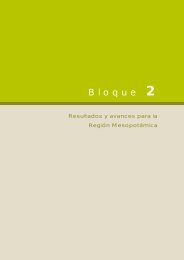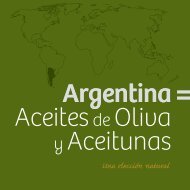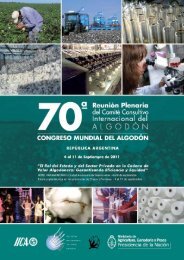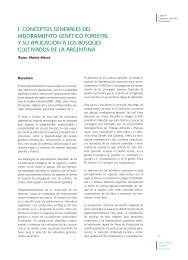PROYECTO FORESTAL DE DESARROLLOaccessions. 68 % of the bands (140) were useful as polymorphic markers. Diversity index average value was0.33 and about 52 % of the loci had values greater than 0.4. Cluster analysis derived from the similaritymatrix revealed no particular grouping among accessions suggesting the absence of closely related genotypes,except for 5 pairs of genotypes. Bootstrap analysis results confirmed the suitability of AFLP to describe geneticrelationships in this breeding population. In addition to AFLP, four highly informative microsatellites were usedto construct an Identification Matrix that allowed the discrimination of nearly all the studied genotypes. Meanvalues for the number of alleles per locus, Nei diversity index and similarity coefficient among accessions were13, 0.78 and 0.19, respectively; indicating that the breeding population has high genetic diversity. However,several genotypes showed the presence of single microsatellite bands suggesting a putatively important degreeof homozygosity. Molecular data were used to design a clonal seed orchard. To this aim, the 9 most divergentpairs of genotypes were chosen; keeping 95.2 % of total number of alleles from the 140 polymorphic AFLPloci and the 4 microsatellite loci analyzed. Mean diversity and similarity indexes for AFLP and microsatellitesshowed no significant variation between the original breeding population and the selected seed orchard;confirming that selection of a seed orchard formed with a limited number of individuals can be carried out todiscard similar accessions and avoid inbreeding.445. Zelener, N. (1).Caracterización de genotipos selectos de Eucalyptus spp. mediante marcadores moleculares.Tesis de postgrado. 4/2003 Maestría en Biotecnología-UBA.(1) Instituto de Recursos Biológicos CIRN–CNIA–INTA, 1712 Castelar, Argentina. smarcucci@cicv.inta.gov.arRESUMENEucalyptus dunnii es un importante recurso forestal <strong>para</strong> la Región Pampeana, por presentar excelentescaracterísticas maderables y ventajas adaptativas respecto de otras especies <strong>del</strong> género. La principal limitaciónen su difusión ha estado relacionada al escaso abastecimiento de semilla mejorada. La mayor parte de la demandade simiente se satisface mediante su importación desde Australia, la cual no deja de ser deficitaria debidoal área limitada de ocurrencia natural de la especie, su poca representatividad en el sector forestal australianoy los altos costos de importación. La instalación de huertos semilleros constituye por lo tanto, unaalternativa que reduce los costos de producción y provee material de propagación adaptado a <strong>las</strong> condicionesclimáticas locales. En este proceso de mejora es importante considerar el mantenimiento de la diversidad genética,<strong>para</strong> el cual el aporte de la información generada por los marcadores moleculares constituye una herramientavaliosa.Con el objeto de definir poblaciones de producción de semilla mejorada se realizó la caracterizaciónmolecular de una población de mejoramiento de E. dunnii, constituida por 37 familias de medio-hermanos(163 individuos) preseleccionadas por sus características fenotípicas. Se analizó un conjunto de 10 loci demarcadores microsatélites altamente informativos, con el objeto de construir patrones de identificacióngenética, estimar <strong>las</strong> distancias genéticas entre los individuos y cuantificar la diversidad genética de lapoblación de mejoramiento.El análisis molecular de los 163 individuos manifestó un valor promedio de Heterocigosidad esperada de0.81, presentando una multiplicidad alélica promedio de 16.7 alelos por locus. El Índice de Similitud medio,calculado por el Coeficiente de Jaccard, asumió un valor de 0.157, observando en el análisis de agrupamientola ausencia de formación de grupos de individuos por familia de pertenencia u origen geográfico, a travésde los dos métodos de ligamiento empleados (UPGMA y COMPLETE). Estas medidas de diversidad sugirieronsuficiente variabilidad genética en la población de mejoramiento, en términos de construir huertos semillerosque proporcionen, a largo plazo, semilla de calidad genética adecuada.La cuantificación de la variabilidad genética dentro y entre los niveles jerárquicos de la población (orígenes,familias, individuos) se realizó mediante el análisis de la varianza molecular (AMOVA). Este análisisevidenció que la mayor proporción de la varianza se debió a <strong>las</strong> diferencias presentes entre los individuos dentrode <strong>las</strong> familias (82,2 %). En base a estos resultados la selección de los individuos candidatos no consideróla familia de pertenencia, ni el mantenimiento de una proporción determinada de individuos por familia.El análisis conjunto de la caracterización fenotípica y molecular permitió elaborar un protocolo de selecciónque modifica <strong>las</strong> estrategias clásicas, basadas solo en marcadores morfo-agronómicos, al incorporar informaciónsobre los niveles de diversidad genética de los individuos fenotípicamente superiores. En base a esteprotocolo se diseñó un huerto semillero de plántu<strong>las</strong> y un huerto semillero clonal.- 168 -
CATÁLOGO PARA LAS REGIONES PAMPEANA Y DELTA DEL RÍO PARANÁEl huerto semillero de plántu<strong>las</strong>, constituido por 93 individuos, mantiene el nivel de diversidad genéticade la población de mejoramiento, conservando el 99 % de los alelos originalmente presentes. La com<strong>para</strong>ciónde este huerto, respecto de un huerto construido solo en base a criterios fenotípicos, evidenció un decrecimiento<strong>del</strong> 20 % en el nivel de Similitud genética promedio y solo un 5 % de disminución en el ÍndiceFenotípico promedio. El huerto semillero clonal, integrado por 24 genotipos superiores no emparentados, tambiénmantiene el nivel de diversidad genética presente en la población de mejoramiento, a pesar de haberseestimado la pérdida de un 30 % de alelos raros (alelos con frecuencias menores al 5 %).La información generada por el empleo de marcadores moleculares le permitirá al mejorador disponer deotra herramienta de evaluación <strong>para</strong> la toma de decisiones a mediano y largo plazo, respecto de <strong>las</strong> estrategiasde mejora genética.PLAGAS EN PLANTACIONESREUNIONES446. Casaubón, E. (1); G. Cueto (2); K. Hodara (2); and A. González (1).Relations among the site, the plague (Platypus sulcatus Chapuis) and the trunk disease in acommercial plantation of Populus <strong>del</strong>toides cv. Catfish-2 located in the low Delta of the Paranáriver (Argentina).XXI St Session International Poplar Commission – IPC 2000 – Poplar and Willow Culture: Meetingthe Needs of Society and the Environment. Portland, Oregon, USA. September 24-30.(1) Estación Experimental Agropecuaria Delta <strong>del</strong> Paraná, INTA, Campana, (Buenos Aires). ecasaubon@correo.inta.gov.ar(2) Departamento de Ciencias Biológicas. Facultad de Ciencias Exactas y Naturales. Universidad de Buenos Aires. Laboratorio104, 4º Piso, pabellón II, Ciudad Universitaria. (C1428EHA). Buenos Aires. khodara@bg.fcen.uba.arSUMMARYIn the Paraná <strong><strong>del</strong>ta</strong> area, poplar commercial plantations are placed in high lands and in low landssurrounded and protected by dams, occupying 14000 ha in the zone. The greatest wood volume is assigned tosawmills and veneering, and a less proportion of the volume is assigned to grinding. This work is aimed atstudying the relation between the plantation site quality with damages caused by “Taladro de los Forestales”(Platypus sulcatus Chapuis), and the relation with other diseases, such as cankers, which affect the trunk until 2m. high and reducing the wood quality and/or its quantity. The taladro is a small and cylindrical coleopterousappertaining to Platypodidae family. This insect burrows galleries within trunks affecting wood quality,decreasing its commercial value, and producing important volume loss in adult plantations when infected tressbreak with the wind effect. This is considered as the most important poplar pest in the region. We alsoanalyzed a disease incidence, which causes cracks in the poplar trunks and bark death. Consequently, thecommercial value of wood quality decreases and may promote volume loss due to the downfall of the infectedplants. We carried out the study in a 2 ha plantation of Populus <strong>del</strong>toides cv. Catfish-2, which is the mostwidespread clone in the <strong><strong>del</strong>ta</strong> area. The plantation was 12 years old, the plants were placed at 3 x 4 mintervals, and a direct relation was found among the forest site, the pest and the disease. The taladro’s attackwas not at random because the most affected trees had greater diameter and height than those no infected,and they were placed in soil types of “albardón endicado”. These trees showed the most quantity of activeholes and cracks at galleries height, as a consequence of the wind effect. The percentage of infected plantsdue to this disease was greater in the best plantation site, probably because of physiological causes, although thepest affected to the plants with smaller diameters than the healthy ones. Low sites, typically from “bañados”protected by dams, presented lower volumetric yields, lower quantity of active holes, less plants broken by thewind at the height of galleries and less cracks in the trunks.- 169 -


